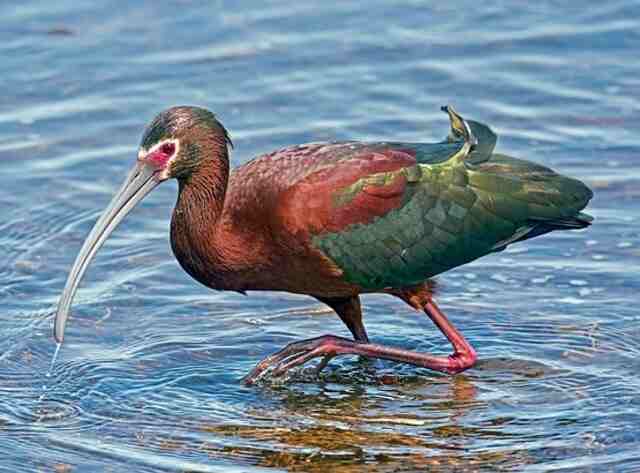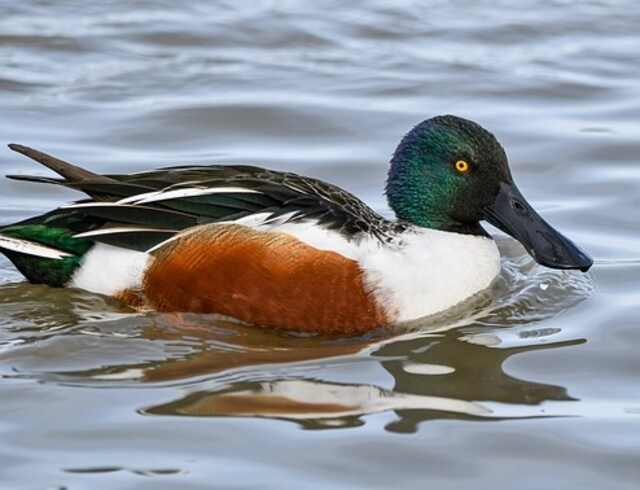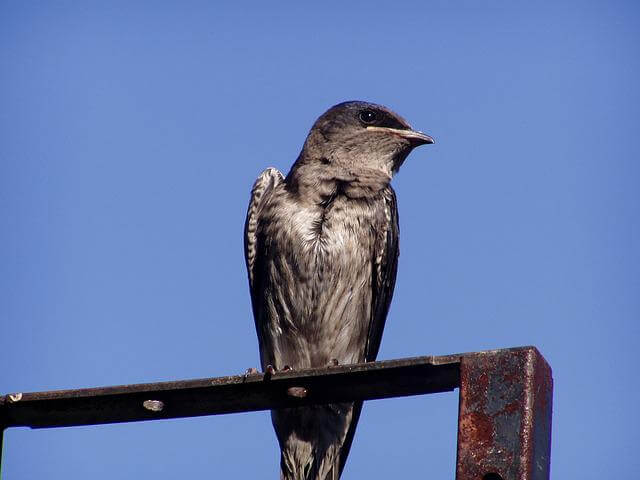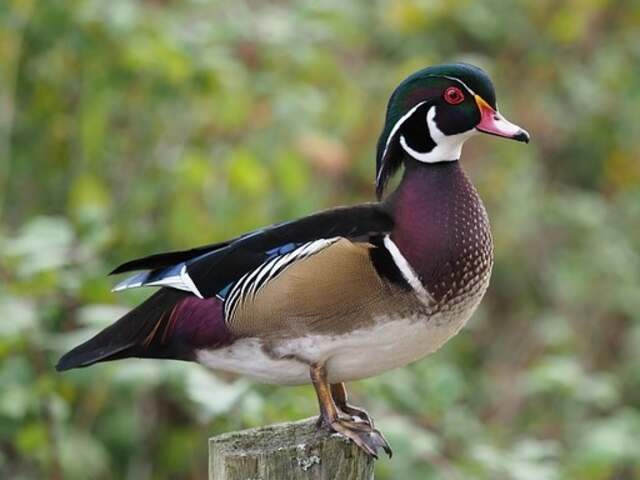Birds with iridescent feathers are among the most visually striking creatures in the animal kingdom. From peacocks to hummingbirds, many species of birds have evolved feathers with iridescent colors that seem to shimmer and change as they move in different lights.
Iridescence in bird feathers is typically caused by specialized structures that reflect and refract light, generating a range of colors and unusual visual effects.
Iridescent feathers play a number of roles in bird behavior, from attracting mates to camouflaging from predators. In this article, we will explore 17 different bird species that feature iridescent feathers and learn about the unique characteristics and behaviors of each one.
Table of Contents
- 1 What Makes Iridescent Feathers Unique?
- 2 Why Birds Have Iridescent Feathers?
- 3 Functions of Iridescent Feathers
- 4 Types of Birds with Iridescent Feathers
- 4.1 Glossy Ibis
- 4.2 Common Kingfisher
- 4.3 Peacock
- 4.4 Rock Pigeon
- 4.5 White-faced Ibis
- 4.6 Ruby-throated Hummingbird
- 4.7 Rufous Hummingbird
- 4.8 Black-chinned Hummingbird
- 4.9 Mallard Duck
- 4.10 Common Grackle
- 4.11 European Starling
- 4.12 Purple Gallinule
- 4.13 Black-billed Magpie
- 4.14 Northern Shoveler
- 4.15 Purple Martin
- 4.16 Tree Swallow
- 4.17 Wood Duck
- 5 Conclusion
- 6 Author
What Makes Iridescent Feathers Unique?
Birds with iridescent plumage are unique because their feathers contain a special structure that reflects and scatters light in a way that creates shimmering, changing colors.
This unique attribute sets them apart from non-iridescent birds and makes them stand out in their environment.
They are often considered more visually appealing than other birds, and their iridescent feathers have been the subject of admiration and inspiration for artists throughout history.
Why Birds Have Iridescent Feathers?
Birds have iridescent feathers to fulfill various functions, including camouflage, communication, attracting mates, and thermoregulation.
Melanosomes, microscopic structures in feathers, are arranged in a way that reflects light, generating the unique and vibrant coloration seen in iridescent feathers.
This is advantageous for many birds, as they are able to use their iridescent plumage to blend in with their surroundings, communicate with other birds, attract mates, and regulate their body temperature.

Functions of Iridescent Feathers
Camouflage
Camouflage is a key function of iridescence in birds. Iridescent feathers allow birds to blend seamlessly into their environment, making it difficult for predators to detect and focus on them. These feathers create a shifting mosaic of colors and patterns that break up the bird’s outline and make it blend in with the surrounding foliage.
This ability to camouflage is critical for survival, as it enables birds to evade predators and stay hidden from view. Iridescence, therefore, plays a vital role in the ecological and evolutionary success of many bird species.
Communication
Communication is another key function of iridescence in birds. Many bird species use their iridescent feathers to convey important messages to other birds in their group. For example, males may use their iridescence to signal their social status and intimidate rivals, while females may use their iridescence to attract potential mates or warn off predators.
The iconic male peafowl (peacock) is a prime example of iridescent communication. During the breeding season, male peafowl display their shimmering feathers in flamboyant courtship rituals, attracting the attention of female peafowl (peahens).
Thus, the iridescence of bird feathers plays a fundamental role in avian communication, enabling birds to signal their intentions and status to others in their social group.
Attracting Mates
Attracting mates is one of the primary functions of iridescence in birds. Many bird species use their iridescent plumage to attract potential partners during the mating season. The bright, shimmering colors of iridescent feathers signal health, vitality, and genetic fitness to potential mates. For example, male peafowls (peacocks) have iridescent feathers that they display in elaborate courtship rituals to attract females.
Similarly, male hummingbirds use their iridescence to attract females by performing high-speed aerial displays, flashing their bright, iridescent feathers in the sunlight. Thus, iridescence can play a significant role in reproductive success for many bird species
Thermoregulation
Thermoregulation is yet another function of iridescence in birds. Some bird species use their iridescent feathers to reflect heat and keep their bodies at a comfortable temperature. The reflective properties of iridescent feathers allow them to absorb and reflect sunlight, reducing the amount of heat absorbed by the bird’s body.
This helps birds to regulate their body temperature and avoid overheating, which can be especially important in hot and sunny environments. Furthermore, iridescence can also aid birds in conserving energy by reducing water loss through evaporation.
Types of Birds with Iridescent Feathers
Glossy Ibis
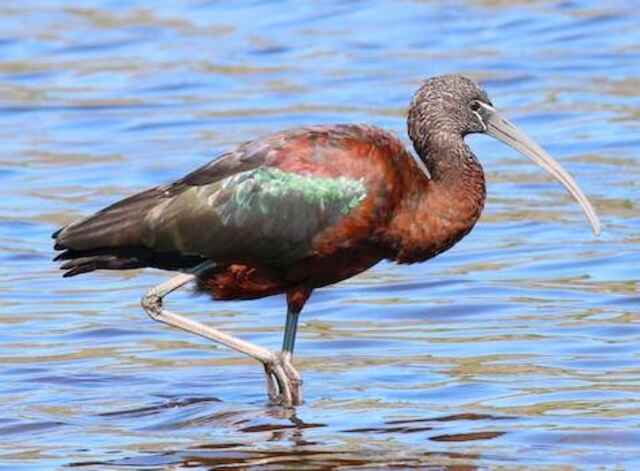
The Glossy Ibis is a long-legged wading bird found in wetlands and marshes throughout the world, including Africa, Europe, Asia, and the Americas. Their plumage is a stunning mix of iridescent bronze, purple, and green, which shimmers in the sunlight. They have a distinctive, curved bill, which they use to probe shallow water and mud for prey.
Their diet consists of insects, small fish, crustaceans, and other invertebrates. The Glossy Ibis often forages in small groups, wading through the water with slow and deliberate steps. Despite their striking appearance, these birds can be difficult to spot as they often blend into their surroundings.
Common Kingfisher
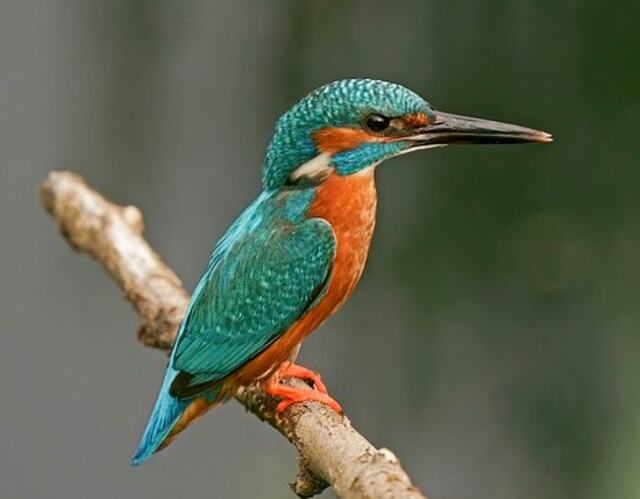
The Common Kingfisher, or Alcedo atthis, is a brightly colored bird that belongs to the Alcedinidae family, which are small to medium-sized birds found in the order Coraciiformes. They are widespread across Europe and Asia and can be found in a variety of habitats including still freshwater streams, rivers, lakes, and sometimes coastal areas. Their diet mainly consists of small fish that they capture by diving into the water from a perch, but they also feed on insects and invertebrates.
One of the most striking features of the Common Kingfisher is its iridescent plumage on its upper parts, which are a result of specialized feather structures that reflect light in a unique way. The iridescence is believed to help them in hunting by camouflaging them and making them less visible to their prey. Additionally, the iridescent feathers may serve as a signal to mates during courtship displays.
Peacock

The peacock is a striking bird known for its iridescent feathers and unique courtship display. These birds are native to South Asia, but have been introduced in many other parts of the world due to their popularity as ornamental birds. The male peacock has a distinctive, colorful plumage consisting of metallic blues and greens, while the female peahen is much more muted in color.
Peafowl are omnivores and their diet consists of seeds, insects, small mammals, and reptiles. The iridescent feathers are thought to play a role in courtship displays, as well as helping them avoid predators by blending in with their surroundings. The feathers are also used as symbols of status, and are highly prized for their beauty.
Read more: The Anatomy of Peacocks: Understanding Their Features!
Rock Pigeon
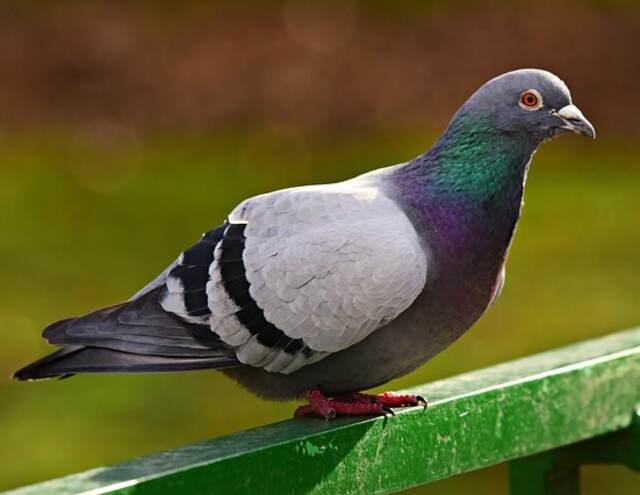
Rock Pigeons, also known as city pigeons or street pigeons, are a ubiquitous and adaptable bird species found across the globe. They have plump bodies, small heads, and short necks, with a range of colors from gray to black to white. They have a varied diet, which includes seeds, grains, fruits, and insects.
Rock Pigeons are found in a variety of habitats, including urban areas, rural areas, and cliffs. They are known for their iridescent feathers, which can appear green, purple, or bronze depending on the angle of light. These feathers are used for courtship displays and to attract mates, as well as to intimidate rivals during territorial disputes.
Read more: Discover 50 Fun Facts about Pigeons (Coos and Surprises!)
White-faced Ibis
The White-faced Ibis (Plegadis chihi) is a bird species with bursty behavior, characterized by their iridescent plumage and long, curved bills. They inhabit wetlands, marshes, and flooded fields in western North America, ranging from Canada to Mexico. Their diet consists of insects, crustaceans, and small vertebrates, which they catch using their sensitive bills.
The iridescent feathers serve as a visual cue to attract mates, signal aggression, and camouflage against predators. The iridescence is created by the unique structure of the feathers that reflect light in a way that produces shifting colors. They also use their iridescent feathers for thermoregulation, as they can adjust their color to absorb or reflect heat.
Ruby-throated Hummingbird
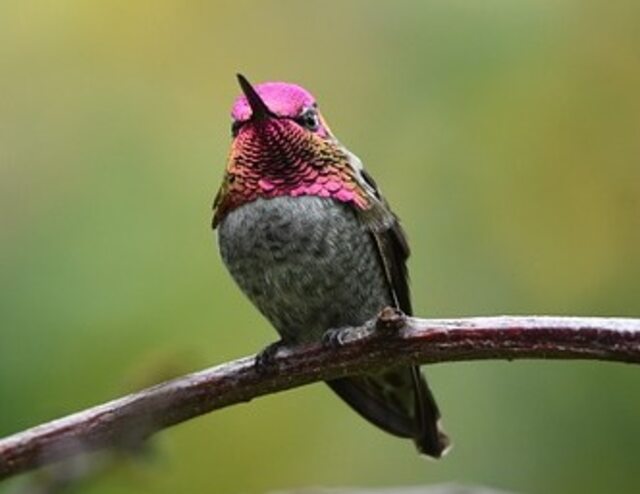
The Ruby-throated Hummingbird, one of the smallest birds in the world, is characterized by its bright green feathers, iridescent throat patch, and remarkable speed. Found primarily in the eastern regions of North America, from Canada to Mexico, these birds prefer habitats that offer nectar-rich flowers, deciduous forests, and open fields.
Their diet consists mainly of nectar and insects, which they obtain by hovering in midair using their incredible wingspan. The iridescence of their feathers serves multiple functions, including mate attraction and species recognition, as well as protection from predators by reflecting light and confusing their vision.
Read more: 31 Flowers That Attract Hummingbirds (Photos, ID & Info!)
Rufous Hummingbird
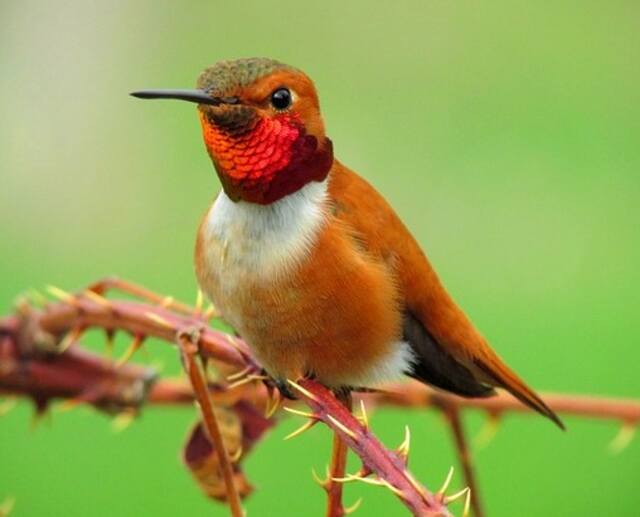
The Rufous Hummingbird is a small but mighty bird, known for its fiery orange plumage and impressive speed. Found primarily in western North America, these birds are known for their migratory nature and can travel great distances each year. They prefer habitats that offer ample nectar sources and may be found in gardens, meadows, and forested areas.
Their diet consists primarily of nectar from flowers, but they also consume insects and spiders. The iridescent feathers on their throat serve a dual purpose – they are used in courtship displays to attract mates and may also serve as a means of communication between individuals.
Black-chinned Hummingbird
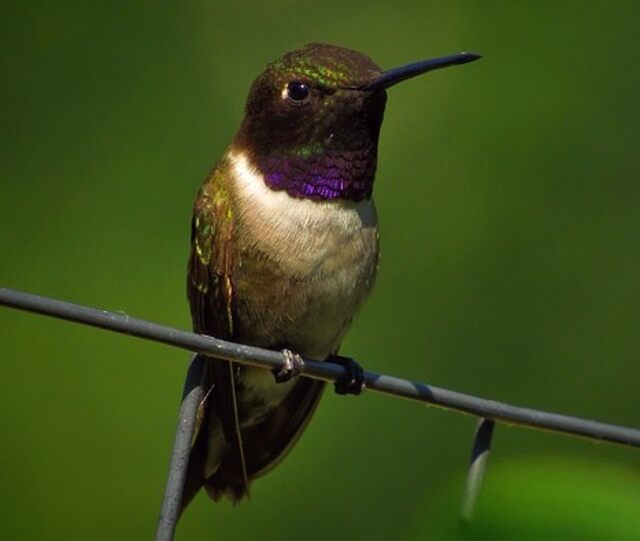
The Black-chinned Hummingbird is a small bird species found in the western United States and Mexico. The male has a metallic green head and black chin, while the female has a pale throat and a green back. They inhabit a range of habitats, including deserts, woodlands, and mountainous regions. Their diet consists mainly of nectar and insects, which they gather while hovering in mid-air.
The Black-chinned Hummingbird is known for its impressive aerial abilities, able to fly forwards, backwards, and even upside down. During the breeding season, males perform elaborate courtship displays to attract mates. Their beautiful iridescent plumage and unique behavior make them a favorite among bird enthusiasts.
Mallard Duck
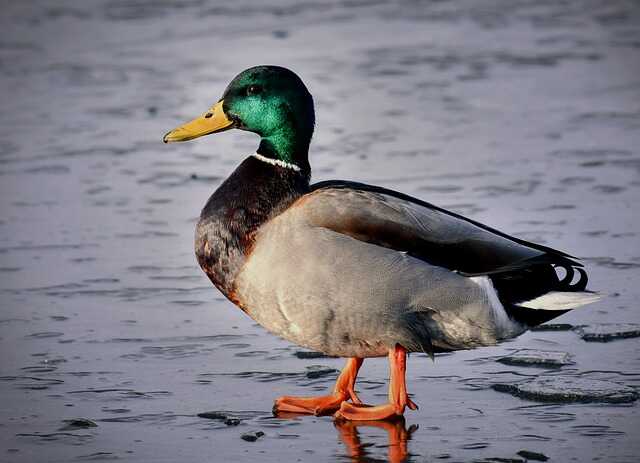
The Mallard Duck is a ubiquitous waterfowl found throughout North America, Europe, and Asia. Recognized by their distinctive green head, yellow bill, and chestnut breast, they inhabit wetlands, ponds, and rivers. Their omnivorous diet consists of aquatic plants, insects, and small fish. The Mallard’s iridescent plumage is caused by the structure of their feathers, reflecting light to produce a shimmering effect.
These flashy colors are vital for communication and courtship displays. Males use their iridescence to attract females during breeding season, while females use it to evaluate potential mates. The iridescence may also serve as a form of camouflage, helping them blend into their environment and avoid predators.
Read more: 23 Fun Facts About Ducks in 2023 (Complete Guide!)
Common Grackle
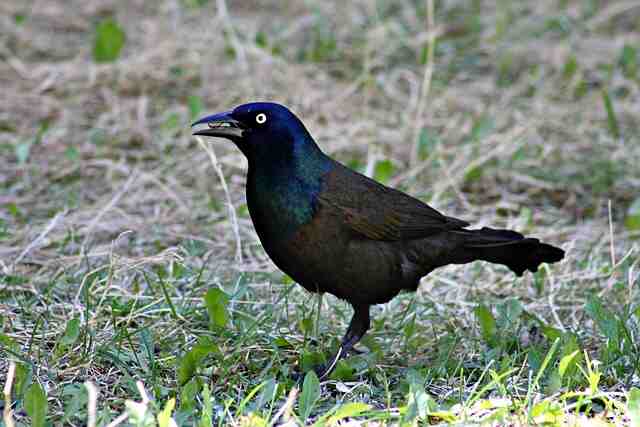
The Common Grackle is a striking bird species found in North America. They have a long, keel-shaped tail and iridescent feathers that shimmer in the sunlight, ranging from deep blue to purplish-black. They are commonly found in open fields, urban areas, and woodlands. The Common Grackle has a diverse diet consisting of insects, seeds, fruits, and small animals.
They are also known for their vocalizations, which can range from harsh squawks to melodic songs. Common Grackles are social birds and often gather in large flocks, especially during the winter months. Despite their beauty and interesting behaviors, they can be considered pests due to their habit of raiding crops and stealing food from other birds.
European Starling
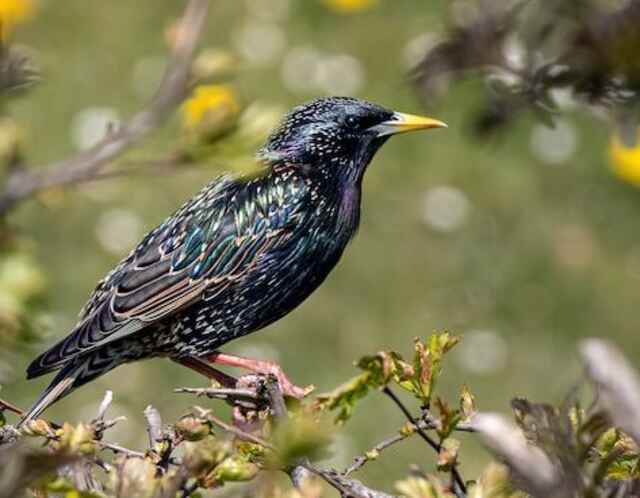
The European Starling also known as the Common Starling is a bird species known for its glossy, iridescent feathers. They are native to Europe and Asia but have been widely introduced to North America. These feathers reflect different colors and play a role in attracting mates and deterring predators. European Starlings are omnivorous and feed on insects, fruits, seeds, and small animals.
They can adapt to various habitats, from urban areas to open fields and forests. Their distribution range has expanded due to human introduction, and they can cause damage to crops and compete with native bird populations. Overall, the European Starling is an adaptable bird with unique iridescent feathers, and their introduction to North America has had significant ecological impacts.
Read more: How To Attract European Starlings To Your Yard Fast?
Purple Gallinule
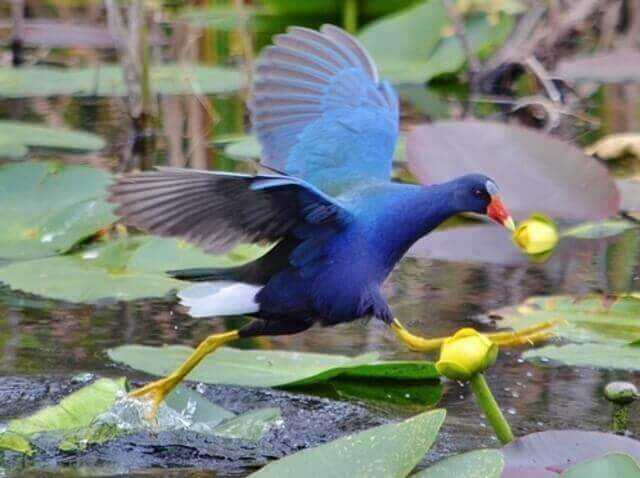
The Purple Gallinule is a bird species found in wetlands across the southeastern United States and South America. They have iridescent feathers that shine with hues of green, blue, and purple, which they use to attract mates and communicate with other birds. Purple Gallinules are omnivores, feeding on plants, insects, and small animals.
They live in various wetland habitats, such as marshes, swamps, and ponds, and are known for their ability to walk on floating vegetation. Their distribution range spans from the southeastern United States to South America, where they inhabit wetland areas. They play a crucial role in wetland ecosystems by controlling populations of insects and small animals.
Black-billed Magpie
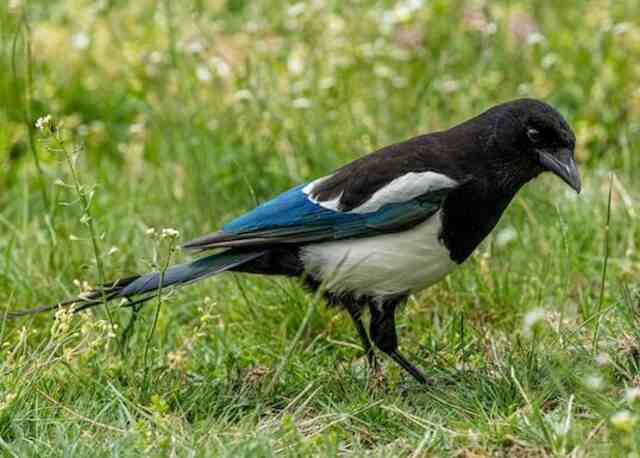
The Black-billed Magpie is a striking bird with distinctive black and white plumage and a long, iridescent tail. These birds are found across much of North America, from Alaska to Mexico, and are commonly seen in open habitats like fields, meadows, and parks. They have a varied diet that includes insects, small mammals, fruits, and carrion. One of the most interesting characteristics of the Black-billed Magpie is its iridescent feathers.
These feathers are thought to serve several functions, including communication, mate attraction, and camouflage. Magpies may use their iridescence to signal dominance or attract a mate during courtship displays, and the shimmering effect can also help them blend in with their surroundings and avoid predators.
Read more: How to Attract Magpies to your Garden? (In 4 Easy Steps!)
Northern Shoveler
The Northern Shoveler is a dabbling duck known for its unique bill that is wider than it is long, giving it a distinctive shovel-like appearance. They are found in North America, Europe, and Asia, inhabiting a wide variety of wetlands, including marshes, lakes, and ponds. Their diet consists of a mix of plants and small invertebrates, which they filter from the water using their specialized bill.
Male Northern Shovelers have iridescent feathers, which serve several functions, including attracting mates and communicating with other ducks. The iridescence is caused by the microscopic structure of the feathers, which reflects and refracts light in a way that creates a range of colors. This is used in courtship displays to attract females and to signal aggression or submission to other males during territorial disputes.
Purple Martin
The Purple Martin, a North American swallow species, is known for its striking plumage and unique characteristics. They have a dark, almost black, plumage with iridescent purple-blue feathers that reflect light beautifully. These birds have a wide distribution range and can be found throughout North and South America during the breeding season, and in parts of South America during the non-breeding season.
They are highly social and form large communal roosts during the breeding season. Purple Martins nest in cavities such as birdhouses, natural tree cavities, or gourds provided by humans. Their diet consists mainly of flying insects, such as dragonflies, mosquitoes, and beetles, which they catch in the air with their agile flight skills. Their iridescent feathers are used in courtship displays and play a vital role in attracting a mate. The coloration also serves as a form of visual communication and helps to establish social hierarchy within the communal roost.
Read more: How to Attract Purple Martins to your Yard (Expert Tips)
Tree Swallow
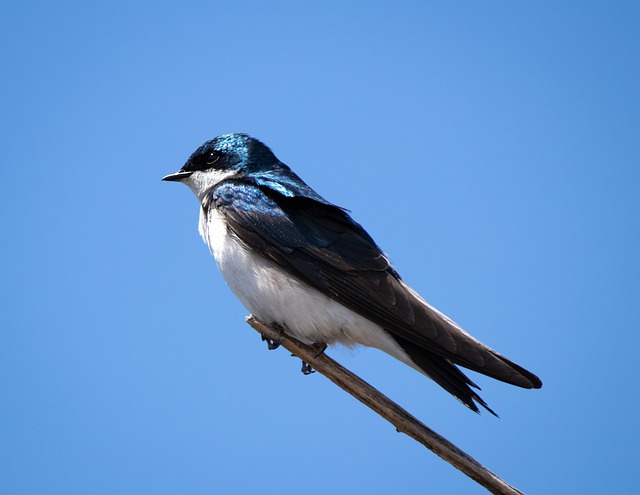
Tree Swallows are small migratory birds that inhabit North and South America. These birds have iridescent feathers on their upperparts, which shine blue-green in the sunlight. They prefer to live near water, such as rivers, lakes, and ponds, and build their nests in tree cavities or man-made boxes. Their diet consists mainly of insects, which they catch on the wing.
The iridescence on their feathers serves multiple functions, including attracting mates, communicating aggression or dominance, and camouflaging themselves from predators. Tree Swallows also use their iridescent feathers to reflect ultraviolet light, which helps them locate food and avoid collisions while flying at high speeds. Overall, Tree Swallows are fascinating creatures that have evolved unique adaptations to survive in their environment.
Read more: How to Attract Swallows to my Yard? (The Expert’s Guide)
Wood Duck
The Wood Duck is a stunningly beautiful bird known for its iridescent feathers, which gleam in the sunlight with a burst of colors. Found throughout North America, these birds prefer wooded areas near water sources such as ponds, streams, and marshes. They have a varied diet consisting of insects, seeds, and small aquatic animals like snails and crayfish. One of the unique features of Wood Ducks is their iridescent feathers, which serve several functions.
Firstly, the shimmering colors help attract mates during the breeding season. Secondly, they serve as a form of camouflage, reflecting the surrounding environment and making it difficult for predators to detect them. Finally, the bright colors also play a role in social hierarchy, indicating the dominant status of a male Wood Duck.
Conclusion
In conclusion, the 17 dazzling birds with iridescent feathers featured in this article are truly remarkable creatures with unique and striking plumage. Their iridescent feathers have evolved for various reasons, such as attracting mates, providing camouflage, and thermoregulation, highlighting their ecological importance.
Observing these birds in their natural habitats is a chance to appreciate the beauty and complexity of the natural world, and perhaps reminds us of our responsibility to protect and preserve wildlife. As we continue to explore and discover more about our world, let’s not forget to admire the magnificent creatures that inhabit it.
Related Post: 12 Stunning Birds With Purple Feathers in North America



